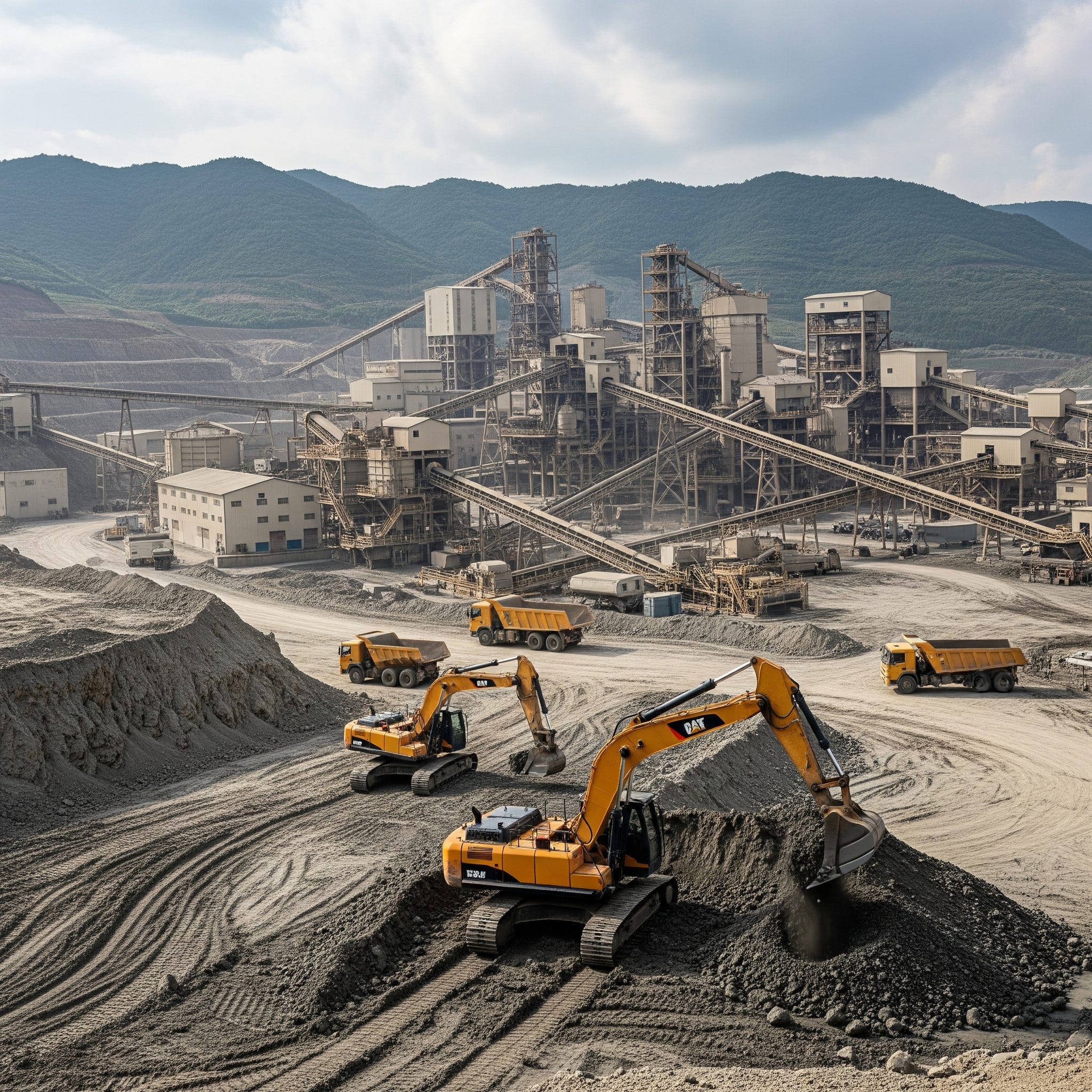Jun 3, 2025
Raw Materials Rising: Part 2
China’s Path to Global Rare Earth Dominance…and What Comes Next
June 3, 2025

This is part two of a two part series on the current state of rare earth element (REE) mining and processing. Part one is available here .
Read the full length article, published by the University of Maryland .
Consolidating China identified and prioritized the REE value chain going back decades, placing its bet on its REE reserves as a strategic and economic lever to use when the time came. The time came in 2025.
Since at least 2008, China has been taking specific actions to consolidate its REE industry and restrict the export of technologies that would see other countries potentially threaten its lead. The timeline of this consolidation warrants examination because it tells the story of a strategic approach that resulted in a commanding economic and geopolitical lead in an era defined by emerging technology competition.
The first significant move China made came in 2008 when it revised its Catalogue of Technologies Prohibited and Restricted from Export (CTPRE). The CTPRE was established by China’s Foreign Trade Law and the Regulations on the Administration of Technology Import and Export and is administered by the Ministry of Commerce usually in conjunction with the Ministry of Science and Technology. The list, which is not public, was revised in 2008 to include REEs and most analysts believe it included the extraction, processing, separation, and utilization technology for REEs. This came at a time when China’s REE industry was still relatively fragmented but nascent efforts were underway to create a strong, globally dominant REE industry.
Just two years later, China found itself in a diplomatic incident with Japan after an at-sea collision near the Senkaku Islands . China’s response was to cut off exports of critical REEs to Japan igniting a multi-year fight at the World Trade Organization. The export quotas (~40%) were challenged at the WTO by Japan, the US, and the EU and after five years, the quotas were removed in 2015.
Subscribe now
Also in 2015, the Chinese government published Made in China 2025 . The plan lays out specific actions the government would take over the next ten years to achieve a set of priorities around making China a manufacturing powerhouse in high tech products. The document prioritizes “self-sufficiency” in manufacturing, which sounds prescient in a post-COVID and current tariff world. Made in China 2025 does not mention REEs specifically but clearly lays the groundwork for what would become the Chinese REE industry as we know it today.
In 2016, the year following the publication of Made in China 2025, the Chinese government completed a yearslong consolidation of its previously fractured REE industry into six major companies :
China Northern Rare Earth Group High-Tech Co. Ltd (based in Inner Mongolia)
China Minmetals Corporation
Aluminum Corporation of China (Chinalco)
Xiamen Tungsten
China Southern Rare Earth Group
Guangdong Rising Nonferrous Metals Group
These six companies now run under effective Chinese state control and are responsible for the extraction and refining of China’s approximately 210,000 metric tons of REE output per year. It is hardly an accident that this consolidation completed the year after Made in China 2025 was published and when read through the REE lens, the document has a very different character. China is nothing if not strategic and it knew it was possibly sitting on a winner as the US, EU, and Japan clearly felt the sting of its export quotas. While China ultimately removed the quotas, a major lesson was learned. China could flex its REE muscle just as oil producing countries had in decades before. It would now need to create an unassailable lead so it could impose its will. Fortunately for China, it has the advantage of being able to direct “private” sector activities and affect such consolidation and vertical integration in a way the US system is not set up to achieve.
In 2023, China again revised its CTPRE to explicitly ban:
REE magnet production technology
REE extraction/separation technology
REE calcium oxyborate prep technology
The revision also added more restrictions around the existing extraction/processing/utilization technologies plus added controls on graphite, gallium, and germanium (all on the USGS critical minerals list).
This timeline tells a compelling story about a country with a strategic vision whose moment arrived in 2010. Since that time, China has used its power to consolidate its REE industry into six major producers and paired that capability with significant export controls. All of this was done BEFORE the Trump Administration kicked off its trade war. No matter how the current trade war ends, China’s CTPRE restrictions and its considerable leads in processing, extraction, and talent are geopolitically daunting. Some analysts argue that the REE card is not as valuable as China thinks. That may or may not prove true, but on the numbers, the US does not have any good near- or medium-term options to cover the delta between its domestic production and China’s and the trade war has certainly not helped.
Leave a comment
US Policy and Legal Moves Meanwhile in the good ol’US of A, the significance of the 2010-2015 REE export quota response to the diplomatic incident with Japan also hit home. Around the same time, the US began to ramp up its policy and legal architecture in response, but there’s a big catch. China took specific actions like restricting export of processing technology and consolidating its REE industry. US policy and legal actions made no comparable move. The US’s response to the REE issue has mainly surrounded defining the criticality of the materials and scoping a strategy, which is largely where it remains.
In 2017, Executive Order 13817 A Federal Strategy to Ensure Secure and Reliable Supplies of Critical Materials was a critical first step that called on federal agencies (and only federal agencies) to:
Identify a critical minerals list (developed by USGS)
Assess supply chain vulnerabilities
Develop strategies to reduce reliance on foreign sources
Streamline permitting for domestic mining and processing
Increase domestic exploration
Enhance recycling and reprocessing
Conduct R&D for alternatives
In 2021, Executive Order 14017 America’s Supply Chains mandated a 100-day review of critical supply chains including critical minerals and REEs. The same year, the Infrastructure Investment and Jobs Act allocated funding for the Department of Energy to run programs on developing domestic critical mineral supply chains to include processing, separation, and recycling (aligned with earlier Executive Order language. USGS also got $3.4 million to collect data and map critical mineral deposits.
One year later, the Inflation Reduction Act provided incentives in the form of tax credits for domestically produced critical minerals to include separated REEs. The US has also used the Defense Production Act to unlock funding for REE grants and contracts. 2022 also saw the passage of the CHIPS and Science Act , which only mentions raw materials in Section 10861 referencing NASA. Also in 2022, the US State Department announced the Minerals Security Partnership including 14 nations plus the European Union at the time of its announcement. This international partnership creates a forum for discussing security issues related to REEs and other critical minerals. What it does not do is consolidate US industry in a way that mirrors or counters Chinese moves in the same space.
Share
Achieving Market Dominance We can decry Chinese actions as unfair, or we can grow up.
China executed a long-term vision based on resources it had onshore and a proven use case of how these resources could be leveraged economically and geopolitically (2010 Japan diplomatic incident). It used its governmental power to consolidate its REE industry and had the foresight to strategically plan through documents like Made in China 2025 and to protect its budding advantage by using the CTPRE. In 2025, as tariff percentages soared above 100%, China’s time came. On the same timeline, the US spent its resources directing the federal government to assess the problem and providing incentives using grants and contracts. This is not intended to cast blame or to pass judgement on which approach was better, but to point out that the US and China are not playing the same game.
The US government does not have the same authority to force the consolidation of its domestic REE industry, so direct counter moves, or tit-for-tat responses will not work. Instead, the US must change its approach and change the game in its favor. Instead of reacting to the moves that China has already made, the US needs to make moves to force reactions from China. That will not come by going mine for mine with China or processing plant for processing plant. It will come through changing the economics of REEs to fit a capitalist model, not an authoritarian one, which China has already done.
Back to the proved reserves list. Proved reserves is a useful concept, but it by no means indicates the total availability of every deposit of REEs in the world. China has 40% of REE deposits but they have also invested heavily in surveying for REEs throughout the country. China’s lead over the past decade has prevented many other countries from entering the REE market given China’s lead in processing and the low costs it is able to charge. But if the US and its allies can get serious about REEs, there is an excellent chance that the game can change. The US is sitting on 1.3% of global proved reserves of REEs but it has also not surveyed as extensively for REEs as it has for coal in the past. In October 2024, USGS announced a previously unknown deposit of between 5 and 19 million tons of lithium beneath Arkansas. While not an REE, this shows that surveys for new mineral deposits are an ongoing process, and it is possible to change the number of proved reserves in your country by focusing and prioritizing.
In an era defined by the pursuit of emerging technologies, the US has been hyper-focused on finished technology products and semiconductors at the highest level. US policy makers are prioritizing domestic manufacture, and manufacturing demands raw materials. That’s a reality that we cannot escape but that does not mean the history is written and the books are closed. China’s focused strategy has paid off so far, but the US and other nations can also choose a strategy. It starts with recognition of the challenge to be solved, what advantages are present, and prioritization. A mistake on top of a mistake is to try to play the game China defined while carrying a message that it is unfair. But a strategy must have momentum and momentum begins with education. When we understand how we got where we are today and why these issues matter, we can build an effective strategy.
We started by talking about lists and lists are illustrative of the problem. We try to boil complex supply and value chains into a “top ten.” This can still be useful, but we need to look in the right direction. Emerging technology leadership means leadership across the value chain. 2025 was already a significant year on the REE timeline, but it has the potential to be significant as a turning point for the US and its allies that changed the nature of geopolitical competition.
View the full length article here .
This is part two of a two part series on the current state of rare earth element mining. Please see part one here .
Connect with us: Substack , LinkedIn , Bluesky , X , Website
To learn more about the AI products we offer, please visit our product page.
Nick Reese is the cofounder and COO of Frontier Foundry and an adjunct professor of emerging technology at NYU. He is a veteran and a former US government policymaker on cyber and technology issues. Visit his LinkedIn here .

